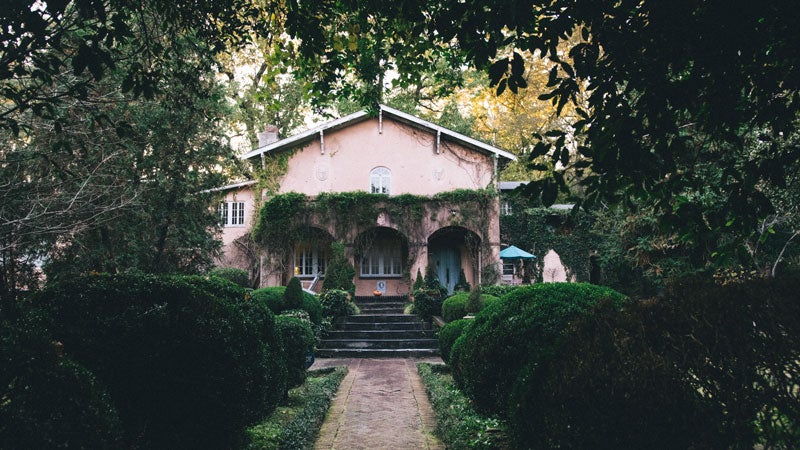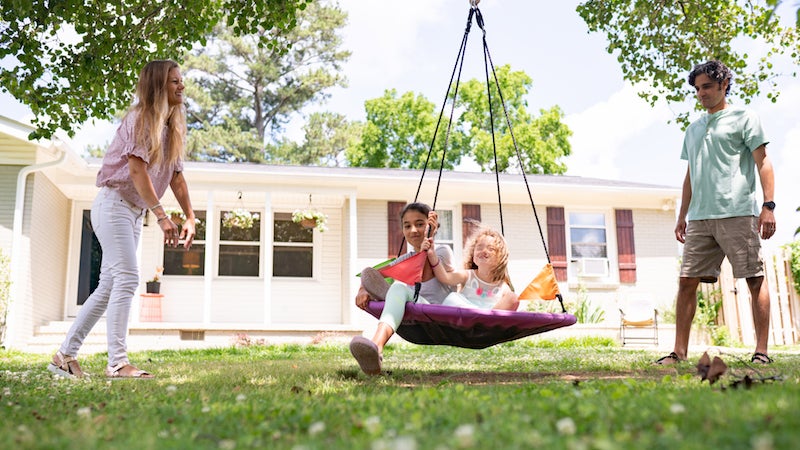Eleanor Bridges was known for her bustling presence and elegant style replete with statement- making hats and chunky heels that elevated her short stature.
The first time Diana Hansen met her was in the early 1980s. Diana, who was president of the Civiettes women’s civic club at the time, was picking up Eleanor, then in her 80s, from her Edgewood Boulevard house to speak at the club’s event that day. Diana never imagined that morning that she’d live in that very house one day.
“I had a little bitty car and she had on this huge hat, and I was so worried all the way down the pathway she wasn’t going to fit in the car,” Diana recalls. “She said, ‘Never you mind’ and took that hat off.’” And so off they went to The Club for the event, where seemingly everyone knew Eleanor. From there they drove back to Eleanor’s home, now commonly known as The Pink House, where she showed Diana around the pink stucco Italianate structure she and her husband, Georges, had built in 1921 and its “secret garden” enshrouded behind tall trees. “It was so beautiful,” Diana recalls. “Every time I would pass by that house (before that day) I would try to peek in there and see.”
A few years later, in 1987, a for-sale sign went up in front of the house. Diana had heard that Eleanor had moved to a nursing home, but she still couldn’t believe her house was being sold. Diana’s husband, Eric, took her to see it. “We walked through that front gate, and he said to the realtor, ‘We came to buy this house.’ And that night we bought it,” Diana recounts. “Eric is a photographer, so he appreciated everything about it.”
With that, two artists of a new generation became the caretakers of the home that two artists who came of age in the 1920s had dreamed up and cared for for decades—nearly a century before it would be named to Alabama’s Places in Peril in 2019.
Meet the Bridges
Eleanor was born in 1899, the daughter of Massey Business College founder Richard Massey. The college taught typing and other clerical skills to provide new opportunities for women in the workforce, and like the school, Eleanor was always a step ahead of her times. “She grew up in that environment and was quite a feminist in her own way,” says Will Womack, a UAB history professor and member of the Homewood Historic Preservation Commission. “She was a bit of a rebel and free thinker.”
Interestingly enough Eleanor’s parents’ palatial house and its Italian-style gardens—which likely inspired Eleanor’s own garden—were demolished in the 1960s to make way for the new Elton B. Stephens Expressway, one of many losses for historic preservation in the same era that landmarks such as the Birmingham Terminal Station met their end.
But years before that, at age 19 Eleanor found her match in a man from Tennessee, Georges Bridges, and they eloped at her parents’ house. The six lots that would become the Bridges’ decades-long home were likely a wedding gift from Eleanor’s father.
At the time most people of the social class Eleanor came from would have lived in more established areas, but not Eleanor. She and Georges were a far cry from conventional in all respects and chose to make their home out off a dirt road in the rural area that was then Edgewood.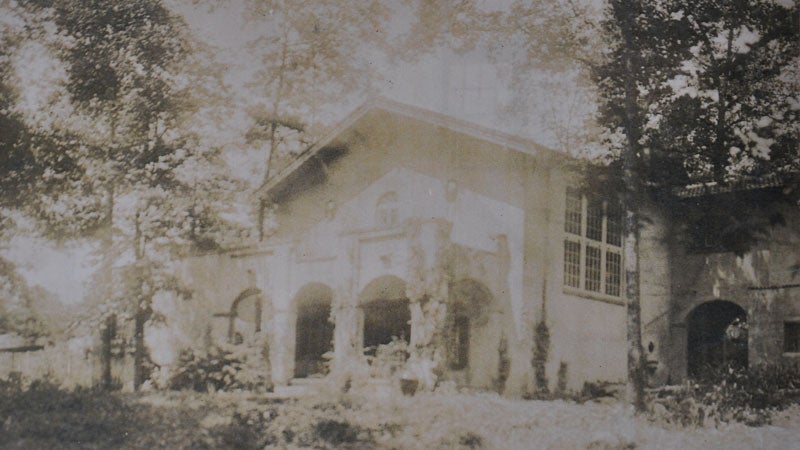
“They had a bohemian sensibility as artists,” Womack says, retelling a story from an oral history with Eleanor. One night when the couple was expected to go to a big society event at the Tutwiler Hotel but instead decided to skip it and the use the money they would have spent that night to buy dinner for homeless people they met. “Eleanor talks about how they got a lot more enjoyment out of talking to people and helping those in need.”
Records indicate that Georges was involved in building the house and also in casting some of its decorative elements. Over the years he worked on his sculptures first in the former stables on the house’s grounds and later at the Old Green Springs Baptist Church building off Green Springs Highway (today it’s the King Cotton building) that Eleanor purchased, ironically, to help preserve it and originally to house a theatre. Today you can see Georges’ work in the family home’s “secret garden” as well as around Birmingham. He cast the Thomas Jefferson monument now on display in Linn Park and the Brother Bryan statue in Five Points, as well as one of a boy and a cat in front of UAB Callahan Eye Hospital. His statues were also acquired in private collections around Europe.
But Georges wasn’t without his own struggles. A World War I veteran, he battled “shell shock,” or what today is called post-traumatic stress disorder, as well as alcoholism for years. The course of his life, and the struggles in their marriage, changed though after he became an early participant in Alcoholics Anonymous. “He said he wasn’t an anonymous drunk, so he wasn’t going to be an anonymous in recovery,” Womack says, referencing a letter from Georges to an AA leader. It has been said that the Bridges went on to host weddings for AA members in their garden.
But through it all, the house “was an anchor for them in their marriage and their travels and tribulations,” Womack says.
Local history author Martha Wurtele Jones recalls the first time she saw the house behind its walls of trees. As a child growing up in Edgewood, she found the Bridges’ Pekingese Mr. Chou when he had escaped his yard. “I took him home, and (Eleanor) showed me the dogs she was working on painting,” Martha recalls. “She had a Russian hound in her dining room she was painting.”
 And indeed Eleanor was a prolific painter, particularly of pet portraits. A collection of 100 of them was at one point exhibited at the Birmingham Museum of Art, and perhaps most famous were her depictions of President Franklin Roosevelt’s Scottie Fala and Gerald Ford’s Golden Retriever Liberty.
And indeed Eleanor was a prolific painter, particularly of pet portraits. A collection of 100 of them was at one point exhibited at the Birmingham Museum of Art, and perhaps most famous were her depictions of President Franklin Roosevelt’s Scottie Fala and Gerald Ford’s Golden Retriever Liberty.
Outside of the home, Eleanor oversaw numerous fundraisers and civic projects and was named Birmingham Woman of the Year in 1953. She helped plan the then-annual Birmingham Festival of the Arts and hosted a Sculpture in the Gardens event featured George’s sculptures that was open to the public. Eleanor also volunteered at Edgewood Elementary School and spearheaded a “100-year plan to make Birmingham the cultural center of the South.”
Fittingly, from the start The Pink House was also known as a salon for new ideas. There the Bridges hosted meetings of the Birmingham Theosophical Society, which came out of a 19th century esoteric spirituality that espoused a series of moral teachers.
Historically, the house also fits into a movement of artists’ gardens created in that era that the Bridges had likely seen on their travels and brought home inspiration from. “That’s one of the things that’s the most historically significant about it,” Womack says. “(The house) was an emanation of their ideas and designs.”
The story goes that the Bridges met expats like F. Scott Fitzgerald and Ernest Hemingway while they were studying art in Europe in the 1920s, and some of these figures could have visited the house. What is fact is that that Eleanor’s boarding school roommate was aviation pioneer Amelia Earhart. “I have a feeling she visited,” Diana says.
A Living Legacy
Stepping back to Diana and Eric’s chapter of The Pink House story, although it had been vacant for three years before the Hansens purchased it, Eleanor’s marks were still all over the home and garden. A life-size portrait of a horse she was working on on canvas hung from the second story, and in front of it lay the scaffolding in the living room she’d used to access the canvas—and she was well into her 80s at the time too. An in-process Cyclorama of Birmingham History that she had been commissioned to complete—on display today at the Birmingham History Center—hung in the house as well.
Upon the sale of the home, it was still filled with antiques and collections from the Bridges’ travels worldwide, and a large metal coat of armor and red velvet curtains remained in the living room. Eleanor had collected bells that were hanging about alongside flowers from the garden she had dried. Most of these items were sold in an estate sale, but the Hansens were left with some of her books, empty hat boxes, a recipe box with index cards with the first lines of speeches she would give and some of her platform shoes telling of her large presence despite her short stature.
One of the hat boxes was emblazoned with the words “White Flowers,” which inspired the name of the gift store Diana would go on to open. Eric would take pictures of Eleanor’s shoes as well as images from the property—statues, bouquets of flowers, gates—and then Diana would make them into T-shirts to sell at the store, which made its home on 18th Street for years and recently moved to Brookwood Village across from Cocina Superior.
In keeping with her theme, Diana had the house’s interior painted white to show off its architecture. The hue replaced the turquoise and mustard yellow that had covered the walls in the Bridges’ era beneath large Oriental rugs that hung down from the balcony.
The Hansens had the power and water connections upgraded when they moved in, but beyond that haven’t updated anything inside the house, even now 32 years later. They chose not to touch the light pink paint on the exterior either since they didn’t want to take down the jasmine vines that crawl up its walls.
The tiny kitchen where Eleanor prepared for her garden parties has no dishwasher today just as was true in Eleanor’s era, and the rest of the house’s features show signs of its 1920s origins. “You almost have to be a peasant to live in that house,” Diana says. “It’s hot in the summer and cold in the winter. We have window air conditioning units, and in the winter you just wear more socks. You have to be willing to put up with that if you want a beautiful garden, and it’s worth it if you care about it.”
The Hansens made one of the two upstairs bedrooms their own, but left alone Eleanor’s meditation room, a space where she’d go to read and think, which is only accessible through a staircase accessible from the back of the house.
While working on a new documentary on The Pink House commissioned by Homewood Historic Preservation Commission, filmmaker Kenzie Greer was struck by how the Hansens have maintained the Bridges’ legacy at the property. “Diana has kept the history of the secret aura of it,” Kenzie says. “There is this glorious window light that peeks through (inside).”
In the garden the Hansens simply sought to continue what Eleanor had sown for decades, watching as surprise lilies popped up in the summer and the cedars and hollies continued to shroud the property in secrecy. “We just felt like caretakers there, we always have,” Diana says.
In its heyday during Eleanor’s time spring ushered in a “pink forest” in the garden with pink dogwoods, red buds and pink wisteria—plus double Russians, yellow violets, a wildflower garden, “varieties hitherto unused here,” and an herb garden that was “Mrs. Bridges’ particular pride,” according to an Anniston Star article from June 25, 1950.
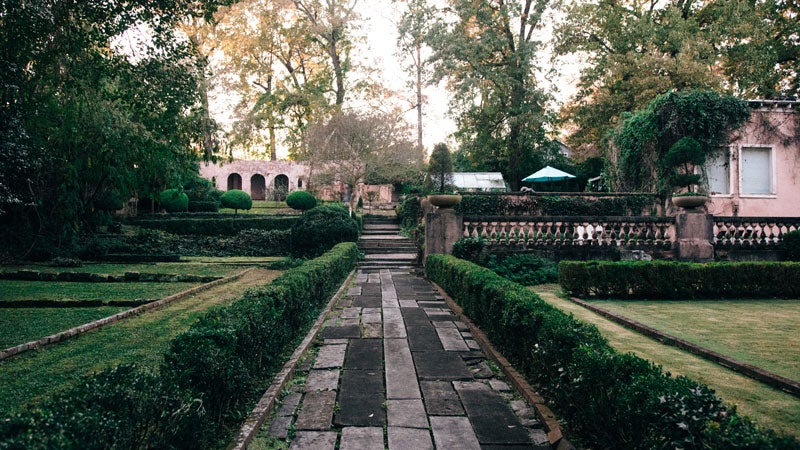 “To tour the Georges Bridges gardens personally conducted by Mrs. Bridges is to glimpse faraway places and ancient civilizations,” the article reads. “Walks, walls, individual plots and vistas are arranged with dynamic symmetry, which pleases the eye subconsciously.” Many of garden blooms came from the Bridges’ travels, and Eleanor introduced some azaleas to Alabama for the first time. “She said she hid (the seeds) in her bustle since you weren’t supposed to bring them back,” Diana says.
“To tour the Georges Bridges gardens personally conducted by Mrs. Bridges is to glimpse faraway places and ancient civilizations,” the article reads. “Walks, walls, individual plots and vistas are arranged with dynamic symmetry, which pleases the eye subconsciously.” Many of garden blooms came from the Bridges’ travels, and Eleanor introduced some azaleas to Alabama for the first time. “She said she hid (the seeds) in her bustle since you weren’t supposed to bring them back,” Diana says.
The house’s natural amphitheater also hosted garden performances of theatrical groups including Birmingham Little Theatre, an organization that provided foundations that led to present-day Virginia Samford Theatre—just one sign of how the Bridges’ legacy lives on decades later. “Her spirit and his spirit are still in the garden,” Diana says. “We can feel them. We are always thinking about them down in the living room dancing together.”
Although the Hansens’ passion for caring for the property has never wavered, its ownership was transferred in 2004 when Diana’s family was in need of money for her father’s medical care for his Alzheimer’s disease. She and Eric sold the home to developer Pat O’Sullivan with an agreement that they could continue to rent it back from them and live there month-to-month with 60 days’ notice if they ever needed to vacate.
Last year O’Sullivan received approval from the Homewood Planning Commission to tear down the house and build five new homes in its place, and following that news the Homewood Historic Preservation Commission, which is associated with the city of Homewood, and the independent Homewood Historical Preservation Society have sought to preserve the building and most recently help find a buyer who could save and restore it.
As of the printing of this article, the future of The Pink House is still yet to be determined, but regardless of its next chapter, the house’s legacy as an artists’ residence will live on in a new documentary on the subject and in the memory of the Hansens and countless others. “Every day I wake up and walk down the stairs and look out the window to see the garden, and I’m grateful to be there,” Diana says. “The garden becomes part of the house. You walk out of the front door and you walk back in, and the garden goes with you.”
UPDATE: Holley Ellis and her family purchased The Pink House in the fall of 2019, just after this article was published, with plans to restore it to its original splendor. You can follow Ellis’ updates on Instagram at @homewoodpinkhouse.
Editor’s Note: Special thanks goes to Diana and Eric Hansen; the Homewood Historic Preservation Commission and particularly members Will Womack, Jake Collins and Suzan Zuber; the Homewood Historical Preservation Society and particularly Martha Wurtele Jones and Dylan Spencer; filmmaker Kenzie Greer; and artist Taren Black for their help with research and artwork for this article.
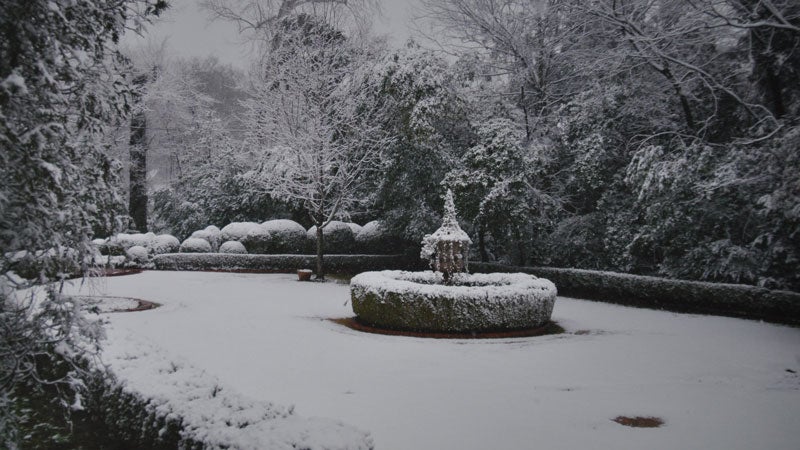
Photo by Eric Hansen
The Pink House on Film
This magazine article is far from the only party interested in preserving the history of The Pink House. The Homewood Historic Preservation Commission (HHPC) commissioned a documentary on the house . HHPC members as well as UAB Media Studies Director Michele Forman, UAB students and UAB graduate Kenzie Greer have all worked on the film.
“It’s raised this question to me on how a city finds a happy medium between evolving and progressing but also preserving its history and keeping the legacy of how it began intact,” Greer told us. “I would like the film to ask that question.” The commission will be announcing dates for film viewings soon.
UPDATE: The documentary on the house premiered in January 2020 at Homewood City Hall and now can be viewed online here.

